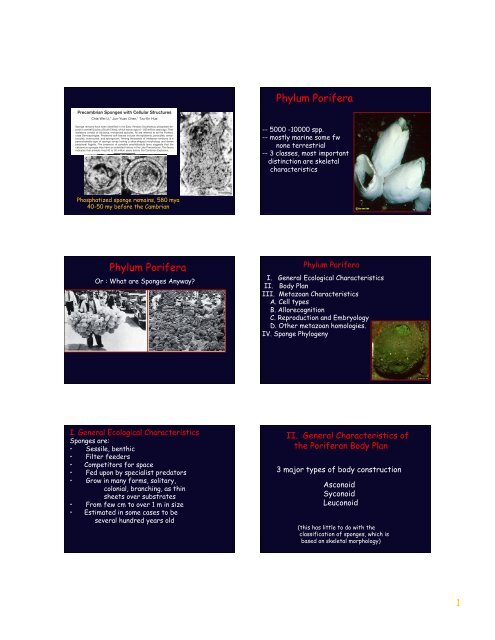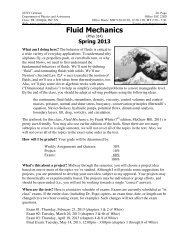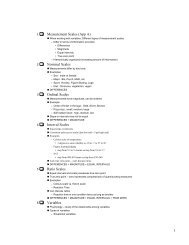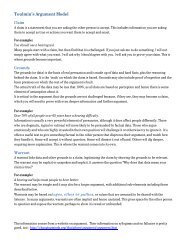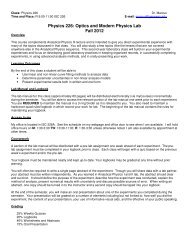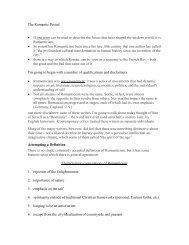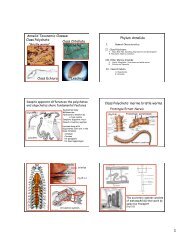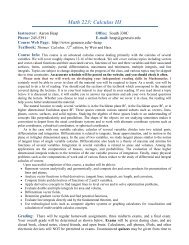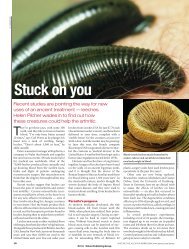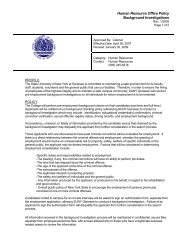Phylum Porifera Phylum Porifera
Phylum Porifera Phylum Porifera
Phylum Porifera Phylum Porifera
You also want an ePaper? Increase the reach of your titles
YUMPU automatically turns print PDFs into web optimized ePapers that Google loves.
Precambrian Sponges with Cellular Structures<br />
Chia-Wei Li,* Jun-Yuan Chen,* Tzu-En Hua<br />
Sponge remains have been identified in the Early Vendian Doushantuo phosphate deposit<br />
in central Guizhou (South China), which has an age of 580 million years ago. Their<br />
skeletons consist of siliceous, monaxonal spicules. All are referred to as the <strong>Porifera</strong>,<br />
class Demospongiae. Preserved soft tissues include the epidermis, porocytes, amoebocytes,<br />
sclerocytes, and spongocoel. Among thousands of metazoan embryos is a<br />
parenchymella-type of sponge larvae having a shoe-shaped morphology and dense<br />
peripheral flagella. The presence of possible amphiblastula larva suggests that the<br />
calcareous sponges may have an extended history in the Late Precambrian. The fauna<br />
indicates that animals lived 40 to 50 million years before the Cambrian Explosion.<br />
REPORTS<br />
Precambrian Sponges with<br />
AnimalsCellular appear in theStructures<br />
fossil record about poorly preserved to be clearly identified or<br />
complex and is composed principally of<br />
565 million years ago (Ma) in Vendian tillite. The were Nantuo shown Formation not toisbe dated sponges from (11). Some<br />
Chia-Wei Li,* Jun-Yuan rocks Chen,* of the uppermost Tzu-En Hua Proterozoic (1), 620 a todisc-shaped 590 Ma. Theimpressions overlying Doushantuo<br />
Formation lia haveisbeen of early reported Vendian as sponges, age, but this<br />
from South Austra-<br />
time known as the Ediacaran. Most of the<br />
Ediacaran fossils are architecturally simple 590 Ma interpretation its base to 565 remains Ma at controversial its top. (11).<br />
It is represented by a phosphate-dolostone<br />
Sponge remains have been identified in the casts Early and Vendian molds, Doushantuo and none ofphosphate them can be deposit<br />
in central Guizhou (South China), which associated has an age without of 580 question milliontoyears extant ago. phyla Their thick and have consists beenmainly from the of dark lowest phos-skeletal fossil<br />
The earliest unequivocal sponge spicules<br />
sequence in Wengan, where it is 33 to 55 m<br />
skeletons consist of siliceous, monaxonal (2). spicules. It is uncertain All are referred whether to as the the Ediacaran <strong>Porifera</strong>, phate, cherty horizonphosphate, in Mongolia chert, (12) and of gray Late Ediacaran<br />
class Demospongiae. Preserved soft tissues fauna include was the spark epidermis, of biological porocytes, diversity amoebocytes,<br />
sclerocytes, and spongocoel. Among that ignited thousands the following of metazoan Cambrian embryos explo-<br />
is taining a theIn uppermost Wengan rocks andofadjacent the Neopro-<br />
parts of central<br />
dolomite. age, The dated Dengying at 543 Formation, to 549 Ma con-(13)terozoic,<br />
is a 180-m-thick dolomite sequence.<br />
It is Ediacaran in age, ranging from<br />
parenchymella-type of sponge larvae having sion a(1) shoe-shaped or was an evolutional morphologyexperiment<br />
and dense Guizhou, late Proterozoic sedimentary rocks<br />
peripheral flagella. The presence of possible that amphiblastula ended in extinction larva suggests (3). However, that 565 the Ma areatrepresented its base and 544 byMa the at its Nantuo, top. Doushantuo,<br />
phosphate and Dengyin bed of Wengan formations con-<br />
(14). The<br />
calcareous sponges may have an extendedboth history comparative in the Late work Precambrian. on hemoglobin The fauna (4) The dark<br />
indicates that animals lived 40 to 50 millionand years calibrated beforerates the Cambrian of nucleotide Explosion. sequence tains a Nantuo well-preserved, Formation diverse (0 flora toassem-<br />
blage including lowermost multicellular unit, uncomfortably thallophytes, overlies the<br />
147 m thick), the<br />
divergence (5) suggested that there was an<br />
acritarchs,<br />
middle<br />
and cyanophytes<br />
Proterozoic<br />
(15). The<br />
Banxi<br />
associated<br />
fauna assemblage, however, had not<br />
extended period of metazoan diversification<br />
metamorphic<br />
that began earlier in the mid-Proterozoic, been recognized. The abundant globular<br />
Animals appear in the fossil record about perhaps about 1 billion years ago. The metazoan embryos had been previously interpreted<br />
as phytoplanktonic organisms<br />
565 million years ago (Ma) in Vendian chance of finding the missing metazoan<br />
rocks of the uppermost Proterozoic (1), a record in the half-billion year long Proterozoic<br />
gap was considered to be almost impos-<br />
Wengan on Beidaoshan, the Doushantuo<br />
(16).<br />
time known as the Ediacaran. Most of the<br />
About 15 km west of the county town of<br />
Ediacaran fossils are architecturally simple sible by some, because it was thought that Formation consists of three units: the Lower<br />
casts and molds, and none of them can be any early animals would be “squishy little Phosphate unit (20 m thick), the Middle<br />
associated without question to extant phyla larva-like things” that would never have Dolostone unit (3.7 m) and the Upper<br />
(2). It is uncertain whether the Ediacaran<br />
phosphate unit (15 m). We prepared thin<br />
been tough enough to show up in the fossil<br />
fauna was the spark of biological diversity<br />
sections (30 m thick) from three rock<br />
record (6). The recent finding of phosphatized<br />
metazoan embryos from basal Cam-<br />
of Lower Phosphate unit. We identified 35<br />
samples of a dark phosphate bed at the top<br />
that ignited the following Cambrian explosion<br />
(1) or was an evolutional experiment brian rocks in China and Siberia (7) indicated,<br />
however, that metazoan embryos are from a 160-cm 2 area of the slides. These<br />
individual sponges with light microscopy<br />
that ended in extinction (3). However,<br />
both comparative work on hemoglobin (4)<br />
sponges are mostly globular but a few are<br />
probably not uncommon as fossils but have<br />
and calibrated rates of nucleotide sequence<br />
tubular (Fig. 1, A and B), and range in size<br />
Phosphatized sponge been overlooked remains, because of their 580 minute mya<br />
from 150 to 750 m. The skeletons consist<br />
divergence (5) suggested that there was an size and nondescript morphology. Here, we exclusively of thin monaxonal spicules that<br />
extended period<br />
40-50<br />
of metazoanmy diversification<br />
before describe an the assemblage Cambrian<br />
of well-preserved are randomly dispersed in the mesohyl (Fig.<br />
that began earlier in the mid-Proterozoic, sponge fossils from the Doushantuo phosphate<br />
deposit (central Guizhou, China) of<br />
1, A, B, D, and F). The spicules survived<br />
perhaps about 1 billion years ago. The<br />
chemical treatment by 4N HCl (on two<br />
chance of finding the missing metazoan<br />
specimens for 20 min), indicating that they<br />
Early Vendian age, 580 Ma (8). are siliceous (17). Most of the spicules are<br />
record in the half-billion year long Proterozoic<br />
gap was considered to be almost impos-<br />
Sponges are the most primitive metazoans<br />
and their presence in the late Protero-<br />
long. The largest is 4 m in diameter and<br />
0.5 to 1.0 m in diameter and 10 to 60 m<br />
sible by some, because it was thought that<br />
zoic has been expected by molecular and 100 m long.<br />
any early animals would be “squishy little<br />
Analysis of the rocks and preservation of<br />
morphological phylogenies (9). Occurrences<br />
of the late Proterozoic (Ediacaran age)<br />
larva-like things” that would never have<br />
the Wengan fossils suggests that the sponges<br />
were buried alive by catastrophic sedi-<br />
been tough enough to show up in the fossil<br />
sponge spicules have been reported previously<br />
(10); however, many were either too<br />
ment<br />
Fig.<br />
incursions.<br />
1. (A)<br />
Phosphate<br />
A possible<br />
alternation<br />
longitudinal<br />
preserveddispersed<br />
the morphological monaxonal details spicules of the (s) softin the mesohyl (m). Two spicules firmly associated with spicule-<br />
section of a tubular phosphatized sponge, showing the randomly<br />
record (6). The recent finding of phosphatized<br />
metazoan embryos from basal Cambrian<br />
rocks in China and Siberia (7) indi-<br />
C.-W. Li and T.-E. Hua, Department of Life Science, sponges, (B) including A phosphatized the epidermis, globular porocytes, sponge in a siliceous background (si); s, spicule. Scale bar, 50 m. (C)<br />
tissues. producing Characteristic cells, the structures scleocytes, of living are encircled and enlarged in (E). so, spongocoel. Scale bar, 100 m.<br />
cated, however, that metazoan embryos are National Tsing Hua University, Hsinchu, Taiwan, China. amoebocytes, Plasmolyzed sclerocytes, epidermal and cells spongocoel, (e) with nuclei (n). The epidermal cell in the square is magnified and is<br />
J.-Y. Chen, Nanjing Institute of Geology and Palaeontology,<br />
Academia Sinica, Nanjing, China.<br />
Many(s) of in the(A). flatScale polygonal bar, epidermal 20 m. (E) cells Amoebocytes (a) in the mesohyl (m). Scale bar, 30 m. (F) Two<br />
probably not uncommon as fossils but have<br />
can be focused seen in athe different Doushantuo plane (insert); sponges. p, porocyte. Scale bar, 30 m. (D) High magnification of the spicules<br />
been overlooked because of their minute<br />
*To whom correspondence should be addressed. have their sclerocytes cytoplasmic (sc) with contents their and developing nuclei spicules (s); pm, plasma membrane. Scale bar, 10 m.<br />
size and nondescript morphology. Here, we<br />
preserved (Fig. 1C). Dense granules surrounding<br />
the nucleus are probably cytoplas-<br />
describe an assemblage of well-preserved<br />
Fig. 2. (A) Spongocoel(so)withundigesteddebris.m,mesohyl;s,spicule.Scalebar,50m. (B–D) www.sciencemag.org<br />
sponge fossils from the Doushantuo phosphate<br />
deposit are framed) (central with yolkGuizhou, granules (y). China) Scale bar, of 50 m. (C and D) Embryosattheblastulastage.Scale<br />
mic organelles. Scattered SCIENCE<br />
among the VOL.<br />
epidermal<br />
cells are porocytes that form incurrent<br />
279 6 FEBRUARY 1998 879<br />
Embryos with uncertain affinities. (B) Ayoungmorula,showingsphericalblastomeres(twoofthem<br />
pores (Fig. 1C). In the mesohyl, amoebocytes<br />
with a variety of shapes were seen<br />
Early Vendian bar, 50 m. age, (E) 580 Aprobablelongitudinalsectionofaparenchymellalarva(pa)withdistinctperipheral<br />
Ma (8).<br />
flagella (f). Flagella in the frame is magnified (insert). Scale bar, 50 m. (F )Abrokenspecimenwhich<br />
Sponges mightare represent the most half ofprimitive an amphiblastula <strong>Phylum</strong><br />
metazoans<br />
and is their connected presence to its parent in the (p) late by a curved Protero-<br />
stalk (st); s, spicule. Scale bar, 50 m.<br />
imens, six spicules were closely associated<br />
larva (aa); e, epithelial cell. Scale<strong>Porifera</strong><br />
bar, 50 m. (G) Abud(b) (Fig. 1E). In one of the best preserved speczoic<br />
has been expected by molecular and<br />
morphological 880 phylogenies (9). Occurrences<br />
of the late Proterozoic (Ediacaran age)<br />
SCIENCE VOL. 279 6 FEBRUARY 1998 www.sciencemag.org<br />
sponge spicules have Or been: reported What previously<br />
(10); however, many were either too<br />
Fig. are 1. (A) A possible Sponges longitudinal section of Anyway?<br />
a tubular phosphatized sponge, showing the randomly<br />
dispersed monaxonal spicules (s) in the mesohyl (m). Two spicules firmly associated with spiculeproducing<br />
cells, the scleocytes, are encircled and enlarged in (E). so, spongocoel. Scale bar, 100 m.<br />
C.-W. Li and T.-E. Hua, Department of Life Science, (B) A phosphatized globular sponge in a siliceous background (si); s, spicule. Scale bar, 50 m. (C)<br />
National Tsing Hua University, Hsinchu, Taiwan, China. Plasmolyzed epidermal cells (e) with nuclei (n). The epidermal cell in the square is magnified and is<br />
J.-Y. Chen, Nanjing Institute of Geology and Palaeontology,<br />
Academia Sinica, Nanjing, China.<br />
(s) in (A). Scale bar, 20 m. (E) Amoebocytes (a) in the mesohyl (m). Scale bar, 30 m. (F) Two<br />
focused in a different plane (insert); p, porocyte. Scale bar, 30 m. (D) High magnification of the spicules<br />
*To whom correspondence should be addressed. sclerocytes (sc) with their developing spicules (s); pm, plasma membrane. Scale bar, 10 m.<br />
www.sciencemag.org SCIENCE VOL. 279 6 FEBRUARY 1998 879<br />
REPORTS<br />
poorly preserved to be clearly identified or<br />
were shown not to be sponges (11). Some<br />
disc-shaped impressions from South Australia<br />
have been reported as sponges, but this<br />
interpretation remains controversial (11).<br />
The earliest unequivocal sponge spicules<br />
have been from the lowest skeletal fossil<br />
horizon in Mongolia (12) of Late Ediacaran<br />
age, dated at 543 to 549 Ma (13).<br />
In Wengan and adjacent parts of central<br />
Guizhou, late Proterozoic sedimentary rocks<br />
are represented by the Nantuo, Doushantuo,<br />
and Dengyin formations (14). The<br />
Nantuo Formation (0 to 147 m thick), the<br />
lowermost unit, uncomfortably overlies the<br />
middle Proterozoic Banxi metamorphic<br />
<strong>Phylum</strong> <strong>Porifera</strong><br />
-- 5000 -10000 spp.<br />
-- mostly marine some fw<br />
none terrestrial<br />
-- 3 classes, most important<br />
distinction are skeletal<br />
characteristics<br />
<strong>Phylum</strong> <strong>Porifera</strong><br />
I. General Ecological Characteristics<br />
II. Body Plan<br />
III. Metazoan Characteristics<br />
A. Cell types<br />
B. Allorecognition<br />
C. Reproduction and Embryology<br />
D. Other metazoan homologies.<br />
IV. Sponge Phylogeny<br />
I. General Ecological Characteristics<br />
Sponges are:<br />
• Sessile, benthic<br />
• Filter feeders<br />
• Competitors for space<br />
• Fed upon by specialist predators<br />
• Grow in many forms, solitary,<br />
colonial, branching, as thin<br />
sheets over substrates<br />
• From few cm to over 1 m in size<br />
• Estimated in some cases to be<br />
several hundred years old<br />
II. General Characteristics of<br />
the <strong>Porifera</strong>n Body Plan <br />
3 major types of body construction<br />
Asconoid<br />
Syconoid<br />
Leuconoid<br />
(this has little to do with the<br />
classification of sponges, which is<br />
based on skeletal morphology)<br />
1
Osculum <br />
Asconoid Sponge<br />
Syconoid Sponge <br />
Ostia <br />
Leuconoid Arrangement<br />
These are the largest, and most sponges<br />
have this type of construction<br />
Carnivorous<br />
sponges from deep<br />
water and shallow<br />
caves<br />
Evolution of<br />
macrophagy from a<br />
microphagous,<br />
filter feeding life<br />
style<br />
Kinship between sponges and protistans?<br />
Further supported by<br />
choanoflagellate vs. choanocyte similarity<br />
II. Other Characteristics of<br />
the <strong>Porifera</strong>n Body Plan <br />
No true muscular system<br />
Lacking sensory organs, nervous system<br />
Often amorphous and asymmetrical,<br />
no anterior, posterior, oral surfaces<br />
Begs the question: Colony of protista or<br />
a simple metazoan (i.e. an integrated animal ?)<br />
2
What is a Metazoan?<br />
III. Metazoan-like Characteristics of Sponges<br />
A. 5 different principal cell types (20 total)<br />
In other words what are the inherent<br />
characteristics of an animal body plan that<br />
are different from that of a colonial<br />
heterotrophic organism?<br />
Choanocyte <br />
spongocoel <br />
Osculum <br />
Pinacocyte <br />
Porocyte <br />
Sclerocytes <br />
Archeocyte <br />
http://www.biology.ualberta.ca/facilities/multimedia/uploads/zoology/<strong>Porifera</strong>.swf<br />
Stem cells – have the capacity of self-replication<br />
and to give rise to more than one type of<br />
mature daughter cells<br />
III. Metazoan-like Characteristics of Sponges<br />
B. Complex reproduction<br />
Image courtesy of BioMEDIA ASSOCIATES<br />
Archeocytes – in sponge embryos are considered<br />
totipotent stem cells that can give rise to an<br />
entire organism<br />
- in adults they produce a few cell types<br />
(sclerocytes, germ cells, etc.) but not an<br />
entire organism; they are considered<br />
pluripotent<br />
Muller (2006) Seminars in Cell and Developmental Biology #17:481-491<br />
III. Metazoan-like Characteristics of Sponges<br />
B. Complex reproduction<br />
III. Metazoan-like Characteristics of Sponges<br />
Unique but complex embryonic development, with a hollow<br />
blastula stage but does not form a gastrula<br />
sperm<br />
Egg<br />
Carried in the plankton<br />
Parenchymula or<br />
Amphiblastula<br />
Juvenile<br />
Settlement &<br />
metamorphosis<br />
Adult<br />
Sexual reproduction involves fertilization, release of a planktonic<br />
larva, and its eventual settlement and metamorphosis on the bottom. <br />
3
III. Metazoan-like Characteristics of Sponges<br />
C. Other sponge metazoan homologies: Epithelium<br />
-- epithelial-like layer homologous to animal epithelia<br />
( ...but typically basal lamina only in Homoscleromorphs)<br />
-- septate junctions (desmosomes) albeit primitive and small<br />
(only Calcarea has full “animal-like” desmosomes)<br />
-- extracellular matrix<br />
-- spongin is collagen-like molecule<br />
-- ubiquitin protein similarity (tag other proteins<br />
for proteolysis)<br />
III. Metazoan-like Characteristics of Sponges<br />
C. Other sponge metazoan homologies:<br />
Regulation of Development<br />
-- True Hox genese are not found, but many homologous<br />
developmental transcription factors are conserved<br />
-- Most of the developmental signaling pathways<br />
(Wnt, Notch) and they are expressed along the same<br />
embryonic “axis” in sponges (and Cnidaria).<br />
Many of these signaling pathways and transcription<br />
factors have not been found in Protists.<br />
From Adamaska et al., 2011<br />
III. Metazoan-like Characteristics of Sponges<br />
B. Non-self recognition<br />
“Metazoan-like Characteristics of Sponges”<br />
Allorecognition<br />
Histoincompatability<br />
“Allorecognition”<br />
Some sponges form new individuals hours after their<br />
cells are separated from one another. If species are<br />
combined, the cells segregate with their own<br />
“Metazoan-like Characteristics of Sponges”<br />
Allorecognition<br />
Histoincompatability<br />
Summary<br />
-- Sponges lack complexity, but their body plan is<br />
ecologically and evolutionarily successful<br />
--They should be considered metazoans<br />
since they have fundamental characteristics of<br />
multicellular animals;<br />
Immune response:<br />
antagonism toward foreign substances<br />
antagonism must be specific toward that substance<br />
future responses should be altered by the first response<br />
--They are derived from flagellated protists but may be a<br />
early and now distant branch of the metazoa;<br />
animals are monophyletic<br />
The sponge immune response is mediated by molecules which have<br />
been found to control histo-recognition in deuterostomes<br />
including Immunoglobulin-like domains and citokines<br />
4
<strong>Phylum</strong> Placozoa<br />
-- 2-3 mm, 25 um- thick, resembling a large ameba<br />
-- Lacks anterior posterior polarity<br />
-- Asexual reproduction is prevalent<br />
--The most primitive animal?<br />
<strong>Phylum</strong> Placozoa<br />
epithelium-like layer<br />
Fiber synctium<br />
Dorsal<br />
cilium<br />
thick glandular layer<br />
Flagellated cells<br />
Intercellular<br />
junctions<br />
- - Feed ventrally by absorption of digested material<br />
- - Lack organs but tissue-like outer walls (no basement membrane)<br />
- - A bit more than 2000 cells<br />
- - Only 4 different cell types (20 in sponges; > 220 in mammals)<br />
- - Smallest genome of all animals<br />
Trichoplax adhaerens<br />
Three competing Scenarios<br />
A. Earliest view of them as the basal metazoan<br />
B. Special cellular junctions consisting of two opposing<br />
dense plaques (desmosomes) not found in most sponges<br />
C. 16S rRNA data…maybe secondarily simplified from more<br />
complex ancestors?<br />
Mitochondrial genome of<br />
Trichoplax adhaerens<br />
supports Placozoa as the<br />
basal lower metazoan phylum<br />
Dellaporta, Stephen L.<br />
et al. (2006) Proc. Natl.<br />
Acad. Sci. USA 103,<br />
8751-8756<br />
Largest known mt genome 46<br />
kbp, 2x that of most metazoa<br />
with introns and other<br />
intrageneic spacers and large<br />
protein coding regions that are<br />
usually lacking in other animals<br />
Blue: known mt proteins<br />
Gray: ribosomal genes<br />
Green: unknown open reading frames<br />
Red lines: introns<br />
(a sponge)<br />
Conclusions?<br />
5


